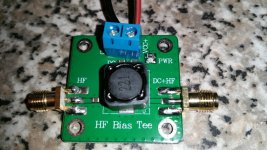Apologies guys, this post (my post) is totally wrongly worded from the start.
@prcguy ... when you say the multicoupler should be protected from a DC supply, do you mean internally; such as a diode or other component to prevent voltage going into the multicoupler input
OR by the user making sure no DC supply goes into the input?
As a way of an update to my original post ...
Firstly, the two wires (positive and negative) that connect to the Bias-T, there was one single strand (almost invisible to the eye) on the positive that got free and any movement was moving that strand towards the negative - causing my power supply to instantly detect a short and switch itself off.
Secondly, my own lack of attention when connecting the Bias-T to the multicoupler. On the Bias-T, I connected the DC+HF to the input of the multicoupler and the HF to the coax to the loop. That was wrong. It should of been the other way around ... the Bias-T HF output should of been connected to the multicoupler input and the DC+HF to the coax to the loop.
I've reconnected my original MLA-30+ Bias-T to the antenna and also to one of my receivers and it works ok. However if I use that or the other Bias-T I've got and connect them to the multicoupler as it should connect, I get nothing from any of the 4 output ports. Clearly I've blown the multicoupler. So guys, my carelessness of connecting the Bias-T the wrong way was one costly mistake!
Thanks
@prcguy and
@Ubbe for your replies. Much obliged to you all.


